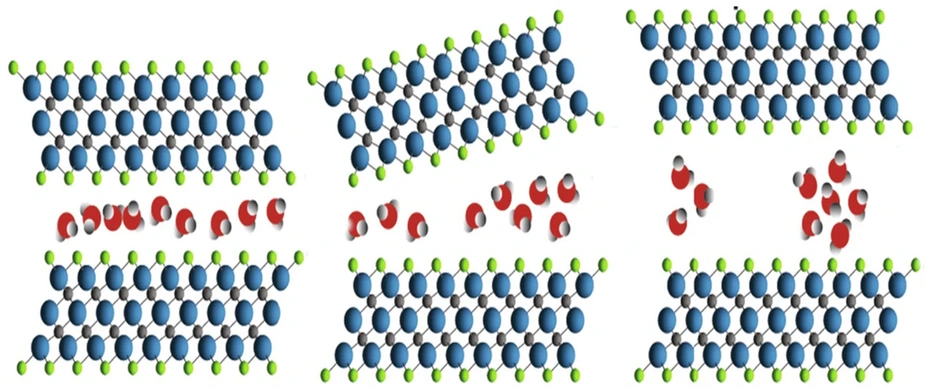MXene as a frame for 2D water films shows new properties
Research team investigates phase changes of confined water at BESSY II
An international team led by Dr. Tristan Petit and Prof. Yury Gogotsi has investigated MXene with confined water and ions at BESSY II. In the MXene samples, a transition between localised ice clusters to quasi-two-dimensional water films was identified by increasing temperature. The team also discovered that the intercalated water structure drives a reversible transition from metallic to semiconducting behaviour of the MXene film. This could enable the development of novel devices or sensors based on MXenes.
Water still has unknown sides. When water is forced into two dimensions by enclosing it in appropriate materials, new properties, phase transitions, and structures emerge. MXenes as a class of materials offer a unique platform for exploring these types of phenomena: MXenes consist of transition metal carbides and nitrides with a layered structure whose surfaces can help them absorb water easily. The water forms an extremely thin film between the individual layers.
A team led by Dr Tristan Petit, HZB, and Yury Gogotsi, Drexel University, USA, has investigated a series of MXene samples containing enclosed water and different ions at BESSY II using various analytical methods.
X-ray structural analysis revealed the formation of amorphous ice clusters in the enclosed water, which increases the distance between the MXene layers. The previously metallic MXene film then becomes a semiconductor. “When heated above 300 K, the clusters dissolve again, restoring the distance between the layers and their metallic behaviour,” says Petit. This metal-semiconductor transition is therefore reversible, unless the water layer is removed. Further X-ray investigations using different techniques revealed unique characteristics in the water hydrogen bond networks.
‘In the next step, we need computer-aided modelling to improve our understanding of the formation of amorphous ice and its impact on electronic transport,’ says Katherine Mazzio, who is co-first author of the study. She concludes that MXene is ideal for investigating the phase changes of confined water, providing new insights into how water behaves at the nanoscale. The use of MXene as a material for energy storage and catalysis is already being discussed, and the role of confined water on the unique MXene properties for these applications is currently being investigated.
Publication:
Nature communications (2025): Conductivity Hysteresis in MXene Driven by Structural Dynamics of Nanoconfined Water
Teng Zhang, Katherine A. Mazzio, Ruocun (John) Wang, Mailis Lounasvuori, Ameer Al Temimy, Faidra Amargianou, Mohamad-Assaad Mawass, Florian Kronast, Daniel M. Többens, Klaus Lips, Tristan Petit & Yury Gogotsi
DOI: 10.1038/s41467-025-62892-7
Contact:
Helmholtz-Zentrum Berlin für Materialien und Energie (HZB)
Dr. Katherine Ann Mazzio
Joint Research Group: Operando Battery Analysis
katherine.mazzio(at)helmholtz-berlin.de
Dr. Tristan Petit
Young Investigator Group: Nanoscale Solid-Liquid Interfaces
+49 30 8062-17153
tristan.petit(at)helmholtz-berlin.de
Dr. Antonia Rötger
Press Officer
+49 30 8062-43733
antonia.roetger(at)helmholtz-berlin.de
Press release HZB, 13 August 2025
